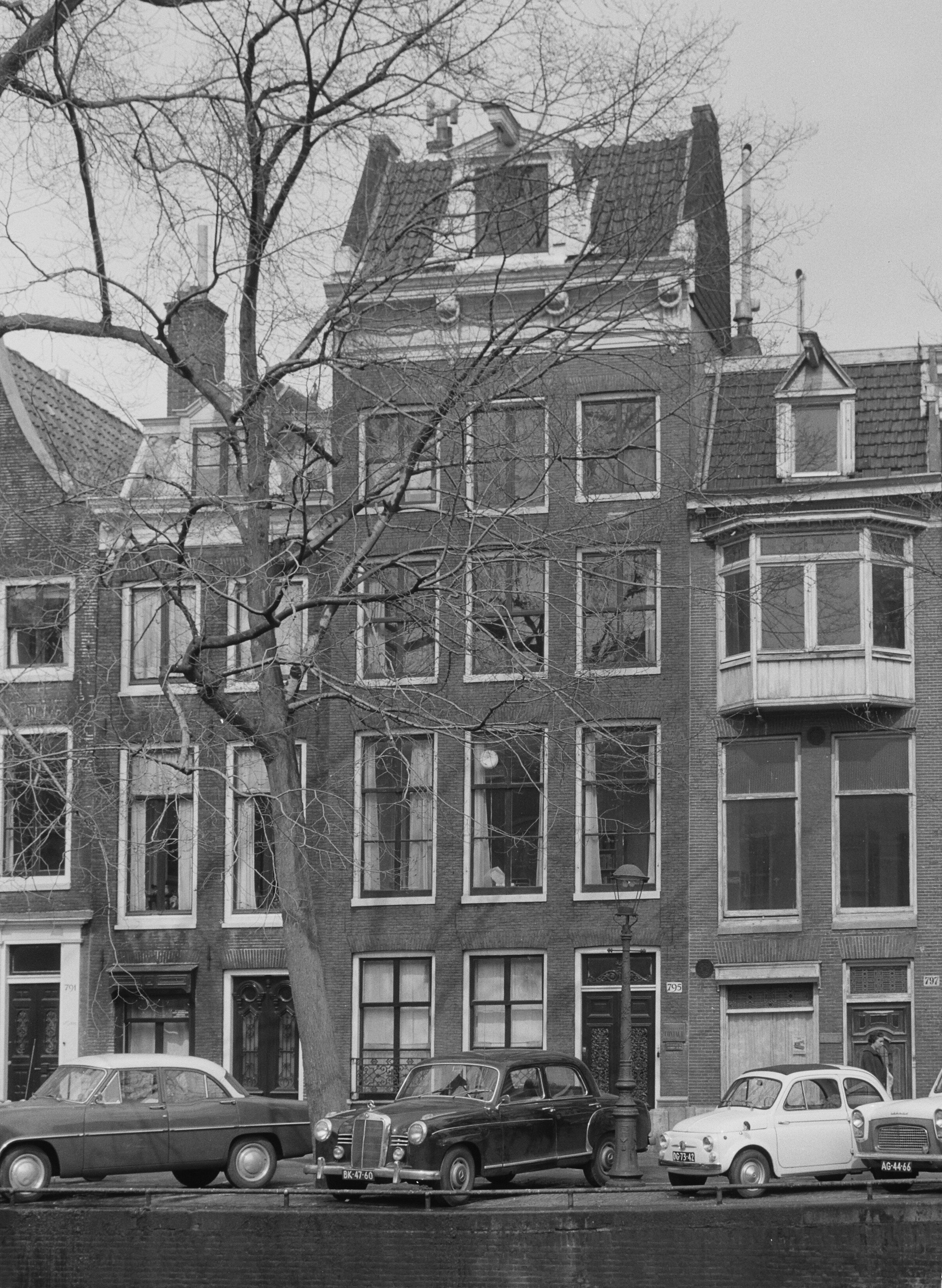Uitgeverij Contact
Uitgeverij Contact was the publisher of the first edition of Het Achterhuis

Uitgeverij Contact, Prinsengracht 795-97, 1962
Vervaardiger: C.P. Schaap. Stadsarchief Amsterdam Copyright: Publiek Domein
In 1933, Contact publishers was founded by Gilles Pieter de Neve. Contact was a distinctly left-wing publishing house during the 1930s, with publications such as We Slaves of Suriname by the anti-colonial writer Anton de Kom. Contact saw it as its mission to warn of the dangers of national socialism and also published many anti-fascist works at the time, such as a critical biography by the historian Konrad Heiden on Adolf Hitler.[1]
After Nazi Germany invaded the Netherlands, Contact therefore destroyed some print runs as a precaution. Thirty-eight publications of the publishing house were banned during the occupation. Despite its earlier anti-fascist stance, the business was not banned or taken over. Contact took a pragmatic stance during the war and published works that were considered "safe". The proceeds were partly used to finance writers who did not join the Nederlandse Kultuurkamer. This institution was set up in the Netherlands by the occupying forces on 22 January 1941 to control and censor the press and the art world.[2] Artists, journalists and writers had to join the Nederlandse Kultuurkamer to be allowed to publish. Contact's financial support allowed some writers to secretly work on books outside the restrictions of the Nederlandse Kultuurkamer, which Contact could then publish after the war.[3]
On 3 April 1946, the front page of Het Parool featured the article 'Kinderstem' by Jan Romein, in which he wrote about Anne Frank's diary. Otto Frank had taken his daughter's book to several publishers, but was repeatedly turned down. After the publication in Het Parool, Contact publishers approached him and they started an exchange of letters about a contract.[4]
Contact was keen to publish Het Achterhuis in the Proloog series. This was a book series linked to the literary magazine Proloog, founded in 1945. It was to be a series of books by young authors. Initially, Otto Frank was not in favour of this. This was because the books in this series had a limit of 240 pages and were not illustrated. These objections were met by the publisher. The first edition of the diary was allowed more pages and included some photos and a map of the secret annex. In addition, Otto was keen to have it recorded that once the first edition was sold out there would be a reprint within six months and that the film and translation rights remained with him. These wishes were granted as well before Otto signed the contract.[5]
The basis for the first edition was the typescript II compiled by Otto Frank. In it, he had deliberately left out a number of passages. These included excerpts in which Anne was critical of her parents' marriage. Contact publishers edited this text and also removed some passages in consultation with Otto. However, there is uncertainty about who exactly made which changes. According to Chris Blom, co-director of Contact, Gilles Pieter de Neve allegedly removed Anne's comments on sexuality and menstruation at Otto Frank's request.[6] In a letter to Chris Blom, Otto wrote that the publisher wished to delete these passages.[7]
The first edition of Het Achterhuis appeared on 25 June 1947 in an edition of 3,000 copies that were sold out with the publisher by early July 1947. The second edition appeared in December 1947 in an edition of 5,000 copies. Two years later in 1949, Contact also published the book Weet je nog, a collection of eight short stories and fairy tales written by Anne Frank. In 1960, Contact also published a wider selection of Anne's stories: Verhalen rondom het Achterhuis.[8]
In 1974, Contact was incorporated into Bert Bakker publishers. Contact's name was still used for a limited number of publications. Until 1984, Contact's logo still appeared on the cover of Het Achterhuis, but at the 67th edition this was changed to Bert Bakker's logo. Contact made an independent restart in 1985, but Bert Bakker continued to publish Het Achterhuis.[9]
In 1993, Bert Bakker then became part of Prometheus publishers. Until 2010, Bert Bakker's logo appeared on the cover of The Secret Annexe. That year, with the 58th edition of the 1991 version revised by Mirjam Pressler, this was changed to Prometheus' logo.
Contact publishers merged with a number of other publishing houses to form Atlas Contact in 2012.[10]
Footnotes
- ^ Toef Jaeger, Uitgeverij Contact 1933-2008: een kleine geschiedenis, Amsterda: Uitgeverij Contact, 2007, p. 5-14.
- ^ Lisette Lewin, Het clandestiene boek, 1940-1945, 2e druk, Amsterdam: Van Gennep, Amsterdam, 1983, p. 45-49.
- ^ Jaeger, Uitgeverij Contact, p. 15-24.
- ^ Lisa Kuitert, ‘De uitgave van Het Achterhuis van Anne Frank’, in: De Boekenwereld: Tijdschrift voor Boek en Prent, Jrg. 24, nr. 1 (oktober 2007), p. 25-26.
- ^ Anne Frank Stichting (AFS), Anne Frank Collectie (AFC), Otto Frank Archief (OFA), reg. code OFA_090: Correspondentie van Otto Frank met Uitgeverij Contact; Kuitert, ‘De uitgave van Het Achterhuis van Anne Frank’, p. 24-26.
- ^ Sandra van Beek, Geschiedenis van het dagboek: Otto Frank en Het Achterhuis, Amsterdam: Pluijm, 2022, p. 58-59; Karen Bartlett, The diary that changed the world: the remarkable story of Otto Frank and the diary of Anne Frank, London: Biteback Publishing, 2022, p. 52-53; Kuitert, ‘De uitgave van Het Achterhuis van Anne Frank’, p. 25.
- ^ AFS, AFC, reg. code OFA_109: Otto Frank aan Chris Blom, 6 augustus 1978.
- ^ AFS, AFC, reg. code OFA_101: Correspondentie en stukken m.b.t. de uitgave van “Weet je nog” 1949 en “verhalen rondom het Achterhuis” 1960, uitgeverij Contact.
- ^ Jaeger, Uitgeverij Contact, p. 29 en 49.
- ^ Zie: Wikipedia: Atlas Contact (geraadpleegd 30 januari 2024).